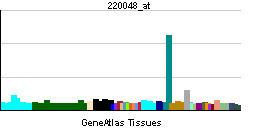Species Human Entrez 10913 | Human Mouse Ensembl ENSG00000135960 | |
 | ||
Aliases EDAR, DL, ECTD10A, ECTD10B, ED1R, ED3, ED5, EDA-A1R, EDA1R, EDA3, HRM1, ectodysplasin A receptor External IDs MGI: 1343498 HomoloGene: 7699 GeneCards: EDAR | ||
Ectodysplasin A receptor (EDAR) is a protein that in humans is encoded by the EDAR gene. EDAR is a cell surface receptor for ectodysplasin A which plays an important role in the development of ectodermal tissues such as the skin. It is structurally related to members of the TNF receptor superfamily.
Contents
Function
EDAR and other genes provide instructions for making proteins that work together during embryonic development. These proteins form part of a signaling pathway that is critical for the interaction between two cell layers, the ectoderm and the mesoderm. In the early embryo, these cell layers form the basis for many of the body's organs and tissues. Ectoderm-mesoderm interactions are essential for the proper formation of several structures that arise from the ectoderm, including the skin, hair, nails, teeth, and sweat glands.
Clinical significance
Mutation in this gene have been associated with hypohidrotic ectodermal dysplasia, a disorder characterized by a lower density of sweat glands.
Derived EDAR allele
A derived G-allele point mutation (SNP) with pleiotropic effects in EDAR, 370A or rs3827760, found in most modern East Asians and Native Americans but not common in African or European populations, is thought to be one of the key genes responsible for a number of differences between these populations, including the thicker hair, more numerous sweat glands, smaller breasts, and dentition characteristic of East Asians. The difference in dentition was not visible in mice due to the radically different structure of mice teeth from human teeth, but it is considered reasonable that that difference also is due to the mutation. The 370A mutation arose in humans approximately 30,000 years ago, and now is found in 93% of Han Chinese and in the majority of people in nearby Asian populations. This mutation is also implicated in ear morphology differences and reduced chin protusion. The derived G-allele is a mutation of the ancestral A-allele, the version found in most modern non-East Asian and non-Native American populations.
In a 2015 study, three (of six) ancient DNA samples (7,900-7,500 BP) from Motala, Sweden; two (3300–3000 BC) from the Afanasevo culture and one (400–200 BC) Scythian sample were found to carry the rs3827760 mutation.
